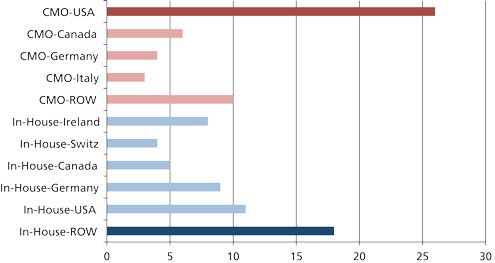Should More Pharma Products be Made in the USA?
PTSM: Pharmaceutical Technology Sourcing and Management
What are the pros, cons, and practicalities of moving pharma manufacturing back to the US? \
The bio/pharmaceutical industry is still buzzing about President Trump’s meeting with pharmaceutical executives on Jan. 31, 2017 (1). While promising the industry lower taxes and less regulation, the President emphasized that those benefits will come only if the industry lowers drug prices and moves more manufacturing back to the United States.
The President’s insistence that manufacturing move back to the US set off a wave of promises from the bio/pharmaceutical industry about the number of jobs that might be created, including a projection by the head of the industry trade association PhRMA that the industry would create 350,000 jobs during the next 10 years if the tax and regulatory changes were enacted. At the same time, it triggered some excitement about the opportunities that might await the contract manufacturing industry in the US if bio/pharma companies chose to outsource the manufacturing of products moved back from offshore sites.
Certain segments of the contract manufacturing organization (CMO) industry have in fact been very US-focused. PharmSource research has shown that of the 99 new drug applications (NDAs) and biologic license applications (BLAs) approved by FDA in 2016, the drug product for 40 (40%) was manufactured exclusively in a facility owned by the sponsor or the sponsor’s partner while 59 had the drug product manufactured by a CMO as either the primary or secondary source. Of the products manufactured at a CMO, 52% of the manufacturing sites were in the US, but only 20% of the captive sites were in the US (see Figure 1).
Figure 1: Dose manufacturing site for 2016 new drug application/biologic license application approvals. (Figure courtesy of author)

The picture for APIs was not quite as favorable for the CMOs. Of the 40 small-molecule NDA approvals that use an identifiable CMO to manufacture the API, only 9 (24%) are made at US manufacturing sites; European API manufacturers account for 70%, a reflection of the traditional dominance of European fine chemical manufacturers. Still, the nine made in the US is still three times the number made in sponsor-owned API manufacturing sites located in the US. Most in-house small molecule API manufacturing was also concentrated at European manufacturing sites. The three outsourced biologic APIs (out of 15 total approved biologics) in 2016 were all made in US facilities.
Moving pharma manufacturing is complicated
Leaving aside the fact that bio/pharmaceutical manufacturing has never really left the US, the realities of the current bio/pharmaceutical manufacturing environment make the prospects for wholesale movement of drug manufacturing a long-term proposition, for the following reasons:
Capacity for manufacturing innovative drugs is tight across the industry, especially for APIs, both small molecule and biologic, regardless of the location of that capacity. Capacity at CMOs is especially tight for anything but immediate release solid-dose products.
While global bio/pharma companies have spent more than $50 billion in just the past five years on new plant and equipment, much of that new capacity has been built in tax-favored locations such as Ireland and Singapore, and in emerging markets. Only about a quarter of the projects have been in the US. There just aren’t many US manufacturing facilities that products could be transferred into from offshore. The facilities that are for sale are old and ill-suited for modern products like biologics.
It takes nearly four years to design, build, and qualify a greenfield manufacturing facility. Large-scale biologics facilities can cost $1-2 billion. It will take time to make and implement the decisions to build the necessary new capacity.
Lead times for ordering/receiving key equipment such as filling lines for injectables are approximately 18 months these days. It takes at least another year to install and qualify it. So even expanding a current facility is likely to be a three-year proposition.
CMOs don’t have a lot of spare capacity and don’t have the cash to invest in massive capacity increases themselves. Patheon’s recent acquisition of Roche’s small-molecule API facility in Florence, SC, was attractive because it was inexpensive and because the facility had lots of unused capacity. Much of the ongoing capacity expansion in the CMO industry is customer-funded.
It can take up to two years to transfer a single product to a new manufacturing site (process transfer and scale-up, validation, stability protocols, regulatory filings, etc.). To move multiple products at one time will take armies of technical, quality, and regulatory staff. Even if enough people with the right skills were available, the time and cost of hiring all those people would be prohibitive.
Even if these challenges could be addressed in a timely and cost-effective way, increasing the US share of bio/pharma manufacturing is not likely to yield the benefits that the administration might be hoping for, especially if it is demanding lower drug prices at the same time. For one thing, any new capacity that is built will likely involve the latest, most efficient technologies, including continuous manufacturing, process analytical technology, and single-use contact parts, so fewer jobs would be created. Further, the new facilities would be designed to maximize the use of labor-saving automation and intelligent systems.
A global market
Finally, it should be remembered that many global bio/pharma companies are headquartered outside the US, notably in Europe and Japan, and will be under their own domestic pressure to keep manufacturing in-house. America-first manufacturing policies are likely to invite retaliation from other countries, which will blunt the job-creating impact.
Realistically, moving bio/pharma manufacturing back to the US in a meaningful way will be a 7-10-year process and is unlikely to deliver a big increase in manufacturing jobs. The bio/pharma industry may find it more expedient to just find ways to put some window dressing on the issue while waiting out the President’s term in office.
Reference
1. R. Hernandez, “President Trump Meets With Pharma Manufacturers,” PharmTech.com, Jan. 31, 2017, www.pharmtech.com/president-trump-meets-pharma-manufacturers-0

Entering New Domains for 3D Printing of Drug Products
April 6th 20253D printing of personalized medications is currently possible under existing compounding regulations, offering enhanced process control through automation. But new legislation coming in 2025 will allow 3D printing as part of a distributed manufacturing framework.